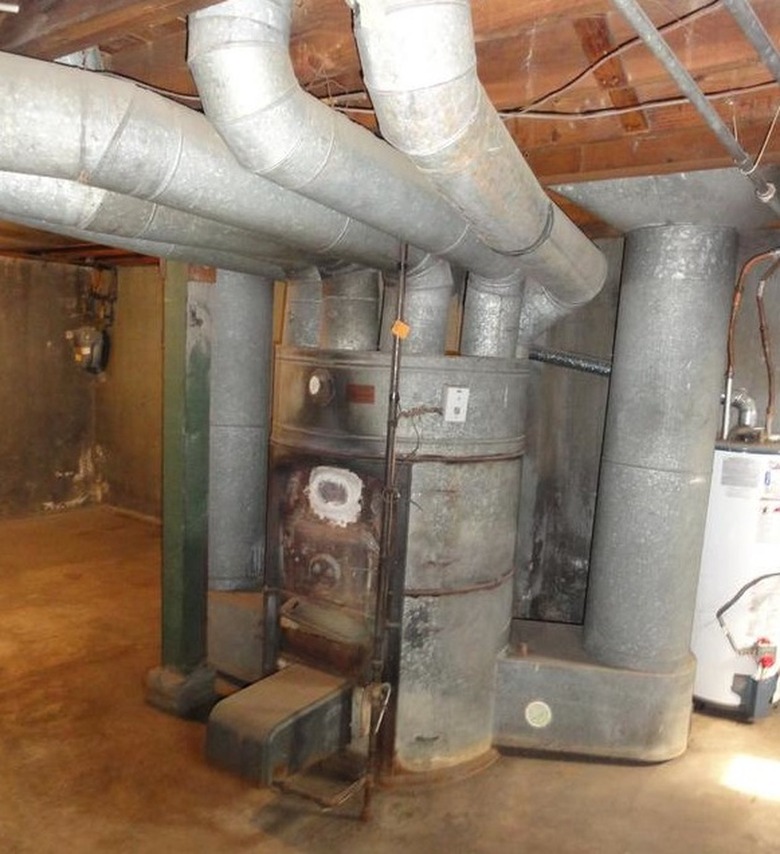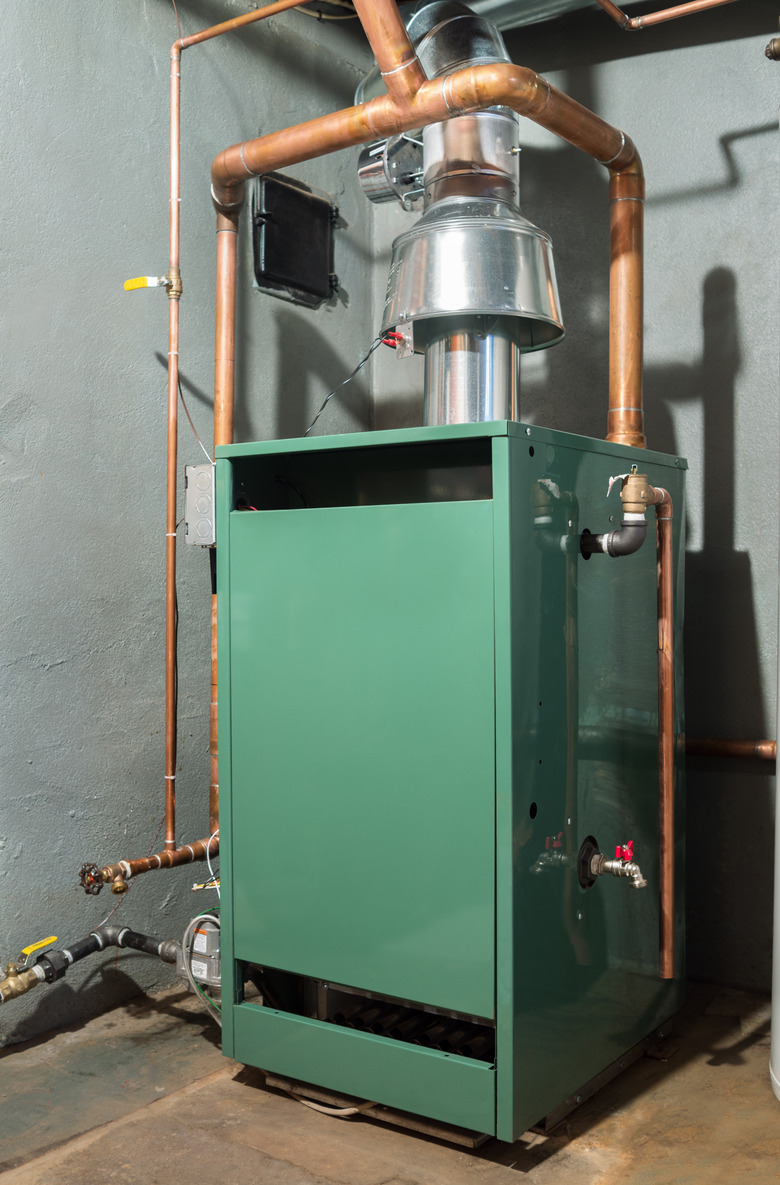Should You Replace A Gravity Furnace?
We may receive a commission on purchases made from links.
Old gravity furnaces are a somewhat rare sight these days since they date back to the late 1800s and were last installed in the 1950s. Still, homebuyers with a penchant for vintage homes may see them pop up on a home inspection — with a stern warning from the inspector that their house needs furnace replacement.
Homes still heated with a gravity furnace are long past due for an upgrade as there are far more cost-effective, fuel-efficient and convenient heating systems available today. Perhaps the only reason to continue using a gravity furnace is to preserve the historical accuracy of the home.
Tip
Unless you're working on a special historic property, it's a good idea to replace a gravity furnace with a conventional heating system.
What Is a Gravity Furnace?
What Is a Gravity Furnace?
Gravity furnaces are so-called because they rely on hot air's natural ability to move against gravity (i.e., rise) in order to disperse air through the ducts and into each room of the home. Therefore, gravity furnaces are always located in a basement. Every room in the home connects directly to the furnace through its own air duct, which means multiple ducts emerge from the top of the furnace. This is how the gravity furnace earned its nickname "octopus furnace."
Gravity furnaces originally burned coal, but many were converted to oil-burning furnaces in the 1950s. Some also run on propane or natural gas. The lack of electrical or mechanical parts has helped gravity furnaces last for decades without breaking down. Without a blower forcing air through the ducts, the system also runs very quietly and delivers a slow and steady stream of heat throughout the home.
In terms of advantages, that's about it. Heating technology has come a long way since gravity furnaces were last in use, and they are now associated with numerous drawbacks.
Disadvantages of Gravity Furnaces
Disadvantages of Gravity Furnaces
The major disadvantage of a gravity furnace is its inefficiency. Oil, natural gas and propane are expensive, so you want most of what you pay for to get converted into heat rather than exhausted as byproducts. Unfortunately, only about half of the heat generated by a gravity system will make it to your living spaces. To put this into perspective, consider that U.S. law mandates all new furnaces to be at least 80 percent efficient, and some models can reach around 97 percent efficiency. An inefficient heating system also creates more pollution and wastes money through higher utility bills.
Gravity furnaces were originally controlled by hand, and later, the system became a little more automated thanks to fuel conversion and the arrival of electric thermostats. However, there's no way to upgrade the efficiency of a gravity furnace just by upgrading to a programmable or smart thermostat. Gravity furnaces use outdated wiring, not the typical 24-volt system, so thermostat options are extremely limited.
Gravity furnaces don't have much to offer from a practical standpoint. After the thermostat tells the unit to turn on, there's no way to control how fast the warm air travels through the ducts and into your home. There's also zero infrastructure suitable for adding air conditioning, which uses the same blower and ductwork as a furnace in modern systems.
Asbestos Is Highly Likely
Asbestos Is Highly Likely
Replacing a gravity furnace is a good idea, but it's not a job that homeowners should do themselves due to the likelihood of asbestos in the duct insulation. Before it became highly regulated in the late 1980s, asbestos was commonly used as insulation thanks to its heat-resistant properties. However, these fine fibers cause cancer and various pulmonary diseases — so DIY asbestos removal is absolutely not recommended.
Asbestos poses no risk until it's disturbed, so if the duct insulation hasn't been torn or otherwise damaged, it should be safe to be near the furnace. If you notice deteriorating insulation on the ducts, call an asbestos abatement contractor immediately and plan to have all of the insulation if not the entire furnace safely removed.
Removing a Gravity Furnace
Removing a Gravity Furnace
Even if a certified inspector tells you that there's no asbestos insulation surrounding your gravity furnace's ductwork, it's still wise to call in a professional crew to handle removal of the furnace. These furnaces were often made of cast iron, which means they are extremely heavy. Pros will have special equipment to remove such a heavy behemoth. Alternatively, you can leave the old furnace and install a new one next to it if you're not short on space.
The ducts should come down, especially if you're installing a conventional gas or electric furnace. These modern units use a completely different ductwork system in which one main duct exits the top of the furnace and then splits off into different branches to serve each room in the home. In contrast, gravity furnace ducts have no branches, making them impractical if not impossible to repurpose.
Choosing a New Heating System
Choosing a New Heating System
Once you've removed or disabled an old gravity furnace, you have complete freedom to choose whatever heating system you want: duct or ductless, electric or natural gas, heat pump or furnace, etc. Your choice depends partially on the climate in your area since a heat pump — an energy-efficient option that also cools your home in the summer — works best in areas with mild winters. Ducted systems are also preferred in hot areas because the same ducts can be used for central air conditioning systems.
Other factors that influence your decision include your expectations regarding upfront purchase and installation costs and long-term utility costs. Electric furnaces are typically cheaper to install but may cost more to operate long term depending on the price of electricity in your area. They're also not the most environmentally friendly option if your electricity originates from a coal-burning power plant.
If you're disappointed about losing the historic authenticity of a gravity furnace, consider installing a boiler system. Boilers also rely on gravity, but instead of hot air that rises, it's steam. The steam enters each room and fills a radiator. Although sleek, modern radiator styles are available, the traditional cast iron radiator has been around since the mid-1800s, which supports the charm of an older home.
Continuing to Use a Gravity Furnace
Continuing to Use a Gravity Furnace
If you decide to continue using a gravity furnace, have it inspected to ensure it's actually safe to do so. You'll want to know that the fuel valve is in good condition, for example, to avoid an uncontained fire or explosion. The integrity of the cast iron should also be inspected since it can still rust and weaken despite its apparent strength.
Like all gas-fired furnaces, gravity furnaces produce carbon monoxide during the combustion process. If the unit isn't vented properly, this toxic gas can leech into your home or collect in the basement. Exposure to low levels of carbon monoxide causes headaches, confusion and sleep problems. At high-enough levels, carbon monoxide kills. Installing a carbon monoxide detector in your home will alert you to a problem so that you can evacuate and call a pro, but it's also smart to proactively call an inspector to evaluate your system for current leaks.
Finally, if the ducts aren't insulated (or if you've had old asbestos insulation removed), consider sealing the seams and adding insulation to improve the system's efficiency. However, if you want to prioritize fuel efficiency and lower utility bills, it's far better to switch to a modern heating system. Gravity furnaces just aren't designed for efficient operation.

